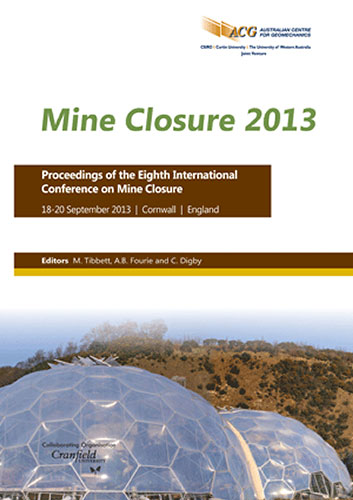Adaptation of the European Union risk assessment protocol for the pre-inventory of Walloon mining waste deposits

|
Authors: Frippiat, CC; Stéphenne, N; Veschkens, M; Pacyna, D |
DOI https://doi.org/10.36487/ACG_rep/1352_42_Frippiat
Cite As:
Frippiat, CC, Stéphenne, N, Veschkens, M & Pacyna, D 2013, 'Adaptation of the European Union risk assessment protocol for the pre-inventory of Walloon mining waste deposits', in M Tibbett, AB Fourie & C Digby (eds), Mine Closure 2013: Proceedings of the Eighth International Seminar on Mine Closure, Australian Centre for Geomechanics, Cornwall, pp. 495-507, https://doi.org/10.36487/ACG_rep/1352_42_Frippiat
Abstract:
European Union Directive 2006/21/EC requires member states to identify closed mining waste facilities potentially posing a serious threat to human health or environment. A general pre-selection protocol was proposed by an Ad-hoc Group of the Technical Adaptation Committee (TAC) of the directive. The protocol considers several criteria, including the presence of pollutants, the stability of the source, four types of pathways and four receptor components. The Institut Scientifique de Service Public (ISSeP) modified the protocol in order to better account for specific regional conditions. The adaptations proposed for the Walloon Region and described in this paper include the exclusion of some criteria, the calculation of additional criteria and a particular combination of source, pathways and receptors to better represent current risks in the region. This method allowed the pre-selection of the facilities needing further risk analysis. The implementation of the pre-selection is done in a geographic information system (GIS) using existing datasets provided either by European institutions (European Environment Agency) or regional authorities (Walloon Public Services – in French, Service Public de Wallonie). GIS inputs include topographic data (location of settlements, surface waters, terrain, etc.), census figures, protected areas, land use/land cover surfaces, delineation of groundwater bodies (according to the Water Framework Directive) and site data that are specific to the waste facilities under consideration (location, contents, geometry, etc.). For the application to the Walloon region, ISSeP excluded several criteria of the protocol based on the regional history of mining activities. New criteria were added, including slope of the heap and impact distance in case of failure. This paper discusses the exclusion choices and the relevance of the new criteria for five types of potential risks: air quality, water resources quality, soil quality, human health in case of direct contact, and linked to heap stability. The additional risk to coal heap combustion is also considered but cannot be included in a systematic risk assessment procedure. Carried out in response to EU Directive 2006/21/EC, the study refers to the protocol proposed by the TAC to inventory closed mining waste facilities. This paper describes its implementation within a GIS based on the European and Walloon datasets and proposes adaptations to deal with regional Walloon specificities. The paper focuses on one risk seen as one of the most relevant in the Walloon case to describe these adaptations in terms of criteria and risk definition. The adaptations have a clear impact on the number of waste facilities pre-selected. At the end of the process, only 30 heaps are selected for further analysis. A detailed investigation of these facilities is planned in the next months in collaboration with the authorities.
References:
Corominas, J. (1996) The angle of reach as a mobility index for small and large landslides, Canadian Geotechnical Journal, Vol. 33, pp. 260–271.
European Commission (2009) Decision 2009/337/EC of 20 April 2009 on the Definition of the Criteria for the Classification of Waste Facilities in Accordance with Annex III of Directive 2006/21/EC of the European Parliament and of the Council concerning the Management of Waste from Extractive Industries (notified under document number C(2009) 2856).
European Parliament and Council (2006) Directive 2006/21/EC of 15 March 2006 on the Management of Waste from Extractive Industries and Amending Directive 2004/35/EC, Statement by the European Parliament, the Council and the Commission.
Health and Safety Executive (1999) Health and Safety at Quarries, Quarries Regulation 1999, Approved Code of Practice, UK, 100 p.
Hungr, O., Dawson, R., Kent, A., Campbell, D. and Morgenstern, N.R. (2002) Rapid flow slides of coal-mine waste in British Colombia, Canada, in Catastrophic Landslides: Effects, Occurrence and Mechanisms, S.G. Evans and J.V. DeGraff (eds), Geological Society of America Reviews in Engineering Geology XV.
Stanley, G., Jordan, G. and Hamor, T. (2011) Guidance Document for a Risk-based Pre-selection Protocol for the Inventory of Closed Waste Facilities as Required by Article 20 of Directive 2006/21/EC.
Stephenne, N., Frippiat, C., Veschkens, M. and Pacyna, D. (2013) From European to regional management of mining waste deposits: adapting to Walloon specificities, in Proceedings of the 33ed EARSel Symposium, 3–6 June, Matera, Italy.
© Copyright 2025, Australian Centre for Geomechanics (ACG), The University of Western Australia. All rights reserved.
View copyright/legal information
Please direct any queries or error reports to repository-acg@uwa.edu.au
View copyright/legal information
Please direct any queries or error reports to repository-acg@uwa.edu.au